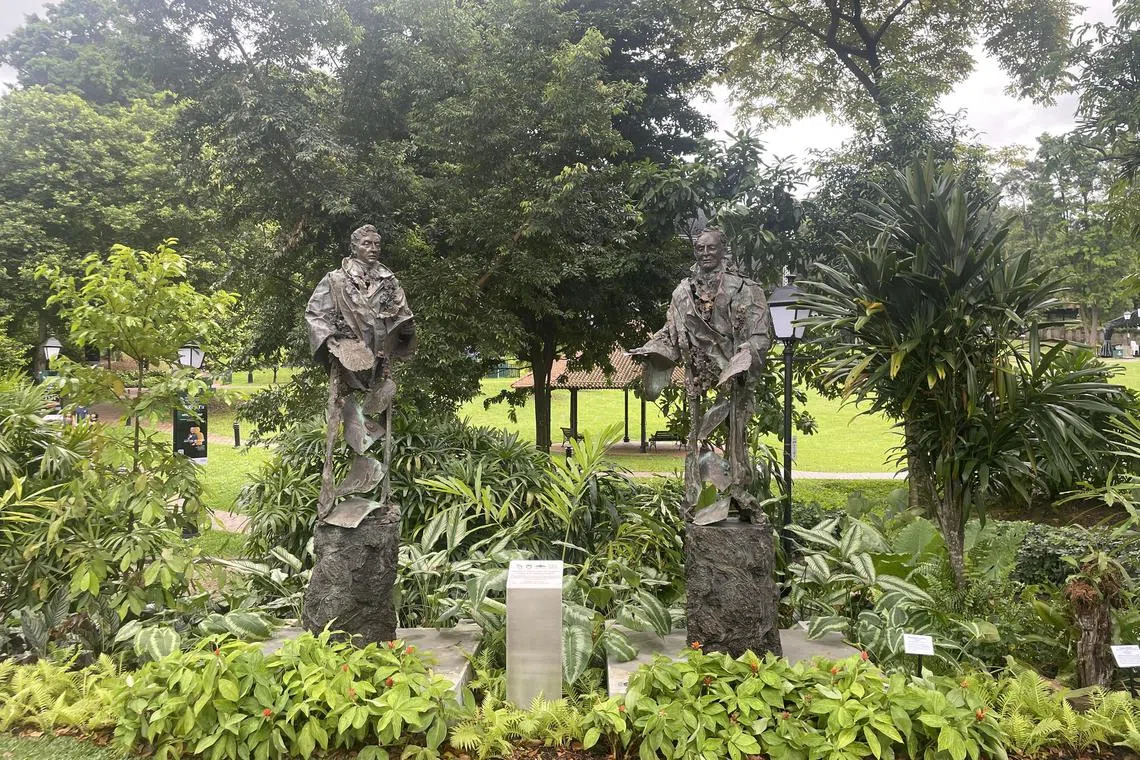Desmond Lee on Fort Canning statues: Singapore built on colonial legacies to become what it is today
Sign up now: Get ST's newsletters delivered to your inbox

Scholars In Conversation: Sir Stamford Raffles & Dr Nathaniel Wallich sculptures at Fort Canning Park.
ST PHOTO: CLEMENT YONG
Follow topic:
SINGAPORE – The acceptance and display of the donated statues of Sir Stamford Raffles and Dr Nathaniel Wallich in Fort Canning Park recognise the colonial legacies that the country has been able to “build (upon), adapt and transform to bring Singapore to what it is today”, said Minister for National Development Desmond Lee on July 2.
Calling this a “clear-eyed view of our colonial past”, Mr Lee also cited examples of Singapore’s administrative, judicial and political systems – including Parliament, which is based on the Westminster model – as current institutions which can be traced back to the British.
“We do not glorify or celebrate it. However, we acknowledge that it is a phase of our history, which stretches way back 700 years to even before colonialism – as we saw in the Bicentennial,” he said in a written parliamentary reply.
His statement was in response to a question by arts Nominated MP Usha Chandradas about the basis for the installation of the two new statues of colonial figures in Canning Rise in May.
The artwork, titled Scholars In Conversation: Sir Stamford Raffles & Dr Nathaniel Wallich, was donated by the Singapore chapter of the alumni of the University of East Anglia, and accepted by the National Parks Board, which administers Fort Canning.
Their erection had sparked fury from some quarters who said this went against movements elsewhere in the world to dismantle, or even topple, monuments of colonial figures – a statue being one of the most public, visible and unnuanced modes of commemorating a person and his achievements.
Mr Lee said: “We need not be afraid of the past. We should be able to reference it with confidence, having regard to all we have achieved together since independence as a people and a nation, and secure in the knowledge that we continue to carve our own destiny and forge our future.”
Despite Singapore’s long history, public commemorations of pre-British figures in Singapore are almost non-existent.
It was only in 2009 when historians Kwa Chong Guan, Derek Heng, Peter Borschberg and Tan Tai Yong published the seminal Seven Hundred Years: A History Of Singapore that a broader shift in thinking about the story of Singapore occurred. Because of post-independence needs, the Singapore story had always emphasised its West-facing identity.
Referencing the global re-examination of colonial histories, Mr Lee said this takes different forms in different places. While it involves a reinterpretation of events or how they are viewed in some, in others it has involved condemnation of all things colonial.
Raffles and Wallich’s contributions “laid the foundation for botanical discovery and science in Singapore and beyond”, he said, and the statues commemorate this heritage and allow visitors to learn more about this.
Mr Lee noted that their contributions go beyond setting up the first botanical and experimental garden in 1822 to the archival. Raffles’ collection of natural history drawings serve as records for the biodiversity of South-east Asia in the 1800s. Wallich also catalogued more than 20,000 specimens, and many of these are now housed in the Singapore Botanic Gardens’ Herbarium.
The current plaque at Canning Rise make no mention of Raffles’ ills, nor do those for the other two statues of Raffles in Singapore outside the Victoria Concert Hall and the north bank of the Singapore River.
During the Singapore Bicentennial in 2019, four temporary sculptures of Sang Nila Utama, Tan Tock Seng, Munshi Abdullah and Naraina Pillai were placed in dialogue with one of Raffles at the Singapore River, presenting a more nuanced view of history. These were removed after the event and not preserved.
There were calls for a more critical engagement with Raffles’ legacy during the Bicentennial celebrations which marked 200 years of Raffles’ arrival in Singapore.
Apart from his racist views and support for the opium trade, he was also in Singapore for no more than eight months between 1819 and 1823, leaving his deputy William Farquhar to do much of the actual work of establishing the new British port – a well-established pattern, given that he was more concerned with higher office in London.
As the governor of Java, Raffles was complicit in the kidnapping of hundreds of women on the excuse of bad conduct and moving them to Borneo for sexual slavery.
There is also evidence of his involvement in the Massacre Of Palembang in 1811, which resulted in the murders of 24 Europeans and 63 Javanese soldiers and civilians at the Dutch fort in what is now Indonesia.


